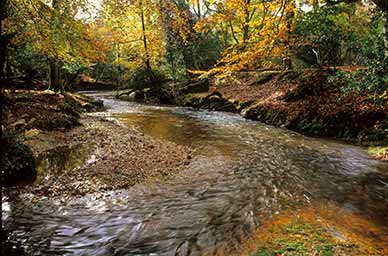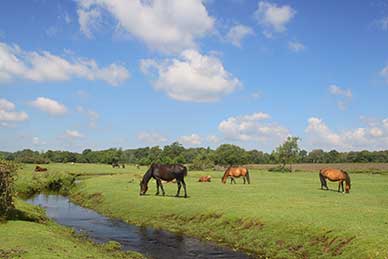Streams and rivers

John Wise, author of The New Forest: Its History and Scenery, first published in 1862, knew a thing or two about the New Forest.
He offered this suggestion: ‘The best advice which I can give to see the New Forest is to follow the course of one of its streams, to make it your friend and companion, and go wherever it goes. It will be sure to take you through the greenest valleys, and past the thickest woods, and under the largest trees. No step along with it is ever lost, for it never goes out of its way but in search of some fresh beauty’.
And the same is true today. Follow one of the New Forest streams from its source to the New Forest boundary and there is a fair chance that every type of landscape, every type of scenery will be enjoyed along the way.
And there are many streams from which to choose: Linford Brook, Dockens Water, Latchmore Brook, Ditchend Brook, Mill Lawn Brook, Highland Water, Black Water, Ober Water, Bartley Water, the Lymington River, the Beaulieu River and far, far more.
Landscape diversity, then, is almost assured; and wildlife present along the way is also likely to be abundant.
From April to September, and sometimes later, slow flowing New Forest streams are likely to be home to myriad dragonflies and damselflies of sometimes baffling variety; and where nutrient levels allow, aquatic vegetation may include magnificent stands of yellow iris and more abundant, but much less showy, marsh St John’s-wort.
Faster flowing, gravel-bottomed streams attract in particular the delightful, beautiful demoiselle damselfly; and where steep-sided, from March until at least mid-summer are home to that brightest of British birds, the kingfisher. Grey wagtails, too, visit to raise their broods before departing in search of easier winter pickings, and little egrets and mandarin ducks are also increasingly seen.
At least twenty species of fish are present in the New Forest streams, ranging from primitive brook lampreys, to eels and even pike, but it is brown trout that most catch the imagination. Many are present all year round, but these are joined in late autumn and early winter by the migratory form of the species, the sea trout, returned from the oceans to breed.
Indeed, there’s no stranger sight than one of these sea-going monsters struggling along the shallow upper reaches of a New Forest stream, searching for gravel beds with good water flows in which to lay its eggs.
Streamside lawns have formed where, in times of flood, water overflows the banks and deposited minerals that enrich the often poor New Forest soils sufficiently to sustain strong growths of grass.
There commoners’ stock congregate – ponies, cattle and donkeys – to enjoy the feast. Deer, too, at dusk emerge from cover to feed, whilst in spring and early-summer, curlews, snipe and occasional redshanks probe the damp ground in search of invertebrate foodstuffs.
Winding ribbons of fresh clean water, all these New Forest streams are largely free of man-made pollutants, although not necessarily man’s influence. Notice, for example, meanders now cut off from the main flow, that still fill with water after heavy rains; and the course of stretches of stream that even to the untutored eye appear to be too straight to be natural.

These are indicators of ‘improvements’ carried out over the last 130 years or so; streams straightened, widened and deepened in efforts to hurry the water through, reducing flooding and consequently improving timber growing and grazing conditions.
In the process of 'improvement', however, important riverine and bog woodland habitats have been badly affected, habitats that are now rare in Britain and the rest of Europe; whilst gravel beds so important for spawning trout have been reduced in size and quality.
But recently, as part of the ‘Sustainable Wetland Restoration in the New Forest - LIFE 3’ project, isolated meanders have been linked back to their parent streams, and other restoration works completed, offering the promise of a return to the streams known to John Wise and his contemporaies in the mid-19th century.
References:
The New Forest: Its History and Scenery: John R. Wise
More links
Other related links
Search this site

Sadly, 58 animals were killed - 35 ponies, 13 cows, 8 donkeys and 2 sheep, whilst a further 32 were injured - 3 pigs, 9 donkeys, 11 cows and 9 ponies.
(Forty-three accidents occurred in daylight, 15 at twilight and 101 in the dark. Twenty-seven accidents were not reported by the driver involved).
Here's just one horrific example - Three donkeys killed in collision with van at notorious New Forest blackspot (Advertiser and Times)
Sika deer continue to engage in rutting behaviour, and will do so until December.
Pigs seek out the remains of the acorn crop.
Beech leaves are transformed into a magnificent mosaic of glorious reds and golds. Other deciduous trees, too, take on an autumnal cloak before their leaves fall.
Dragonflies can occasionally be seen on the wing on bright days early in the month.
December
Foxglove leaves survive the winter at ground level, and offer the prospect of colourful summer blooms to come.
Redwings and fieldfares, autumn and winter visitors, gorge on haws and holly berries.
Great grey shrikes and hen harriers hunt over the heaths and other open spaces.
Honeysuckle by the end of the month often shows welcome signs of new growth.

